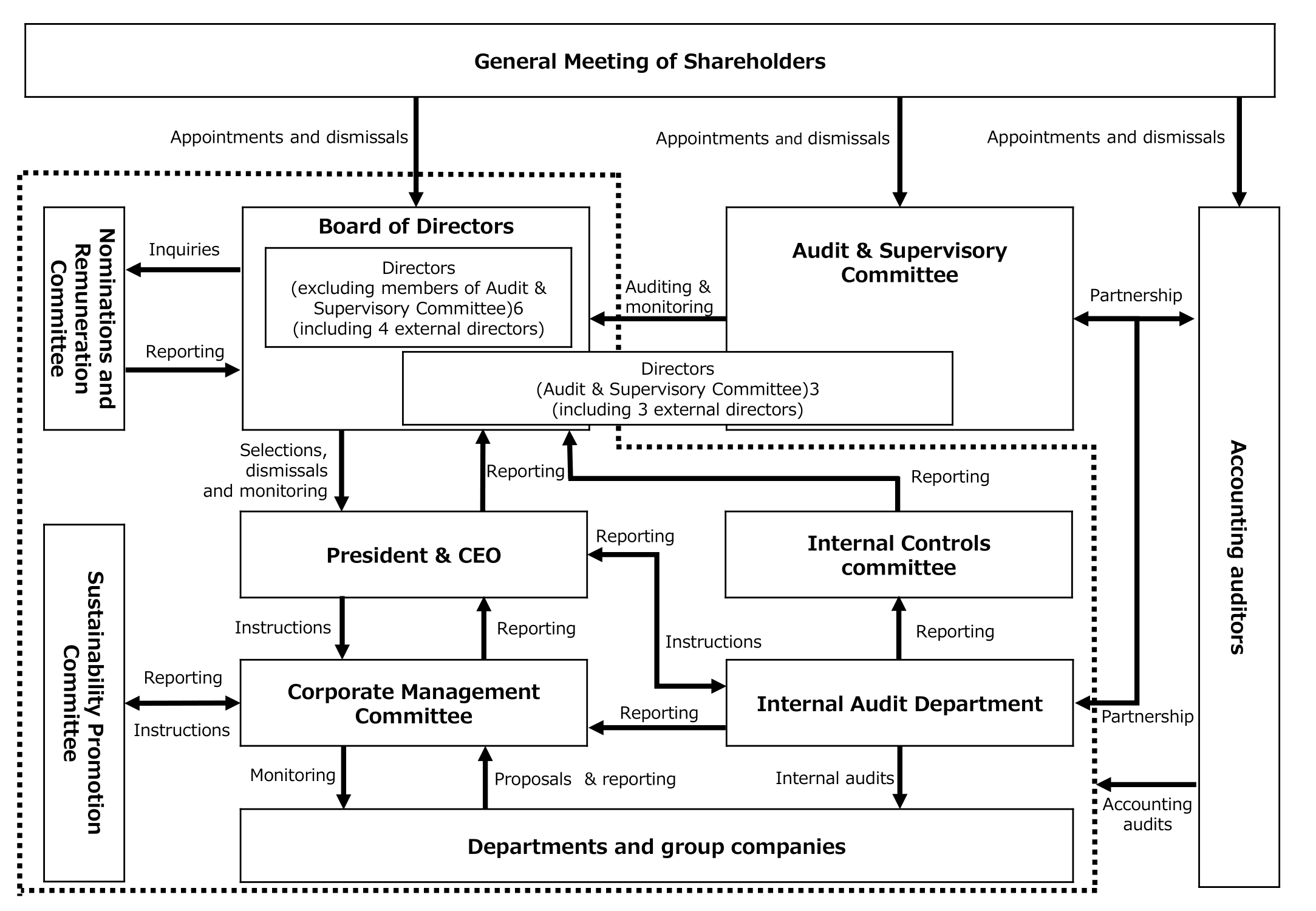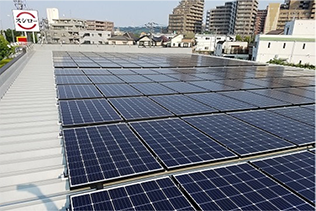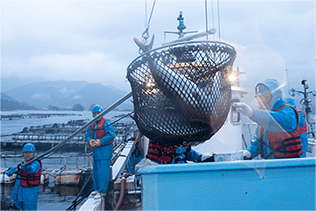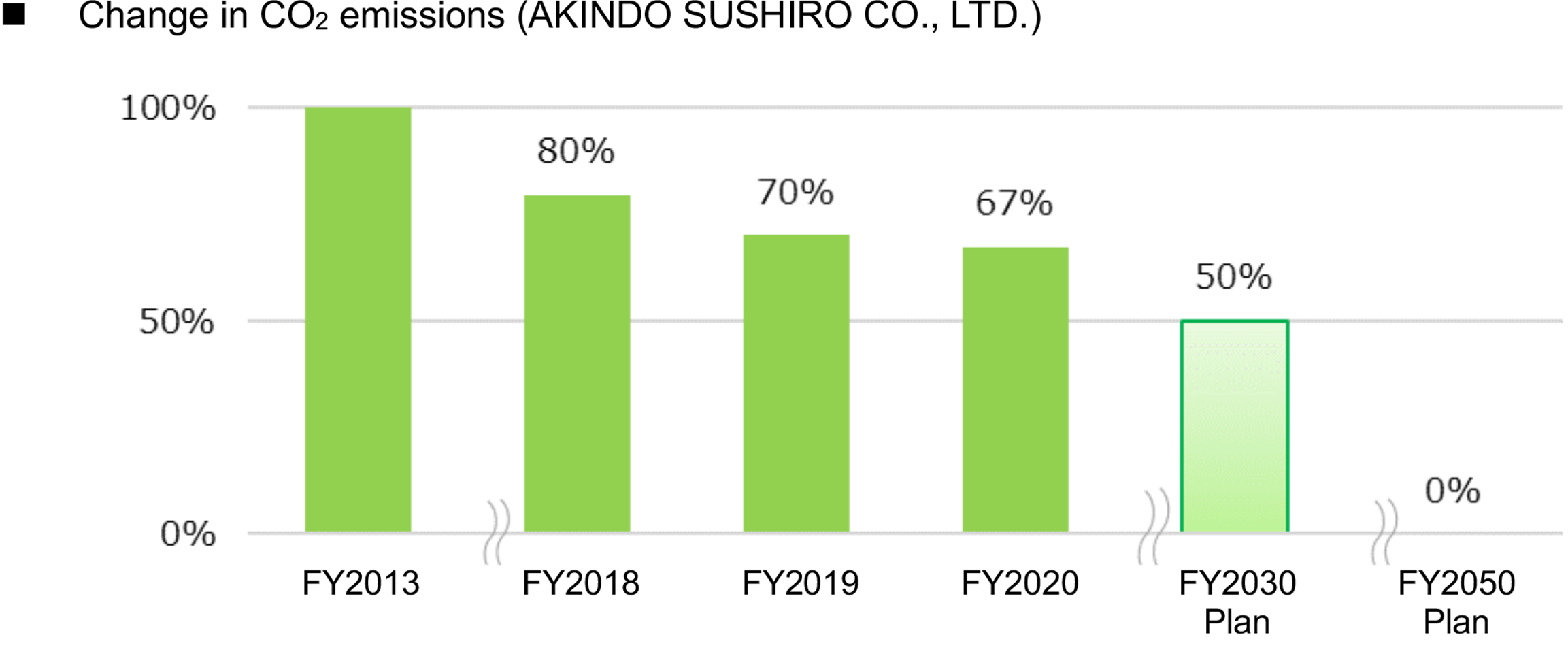Response to the TCFD recommendations
The FOOD & LIFE COMPANIES (“F&LC ” hereafter) embraces the vision of “Discovering new tastiness, Sharing moments of joy.” To continue to provide customers with safe and delicious food, sustainable initiatives that anticipate the future are essential in our business activities. In particular, since the F&LC uses a wide variety of marine and agricultural produce as raw ingredients, it sees climate change as one of the key management risks it faces, and is committed to disclosing climate-related information in accordance with the recommendations of the Task Force on Climate-related Financial Disclosures (TCFD).
1. Governance
The F&LC Board of Directors recognizes the problem of climate change as one of its key management issues and fulfils a related supervisory role. Specifically, the Board of Directors engages in deliberations that take into account the risks and opportunities associated with climate change issues when formulating management strategy, management plans and other key policies, and fulfills a supervisory role as needed in response to responds from various group companies and divisions.
The F&LC has clearly positioned sustainability as a Groupwide management issue, and has established the Sustainability Promotion Committee, chaired by the President & CEO, to drive the implementation of sustainability initiatives. The Sustainability Promotion Committee reports as needed to the Corporate Management Committee on the status of sustainability efforts including action on climate change, and receives instructions and advice. In addition, as needed the President & CEO reports on these conditions to the Board of Directors as appropriate.

2. Strategy
Based on the framework advocated in the TCFD recommendations, the F&LC identified the risks and opportunities that climate change poses to the companies, and conducted analyses using different climate-related scenarios. Going forward, the F&LC will seek to minimize the risks and maximize the opportunities on the way to achieving a decarbonized society by pursuing risk and opportunity-related analyses in greater depth.
When conducting the scenario analyses, we identified the risks posed to the F&LC in relation to climate change, and conducted scenario analysis on those risks expected to have a particularly significant impact on the F&LC. In response to the scenario analysis results, we have organized the response measures needed to minimize the risks and maximize the opportunities. In particular, a detailed analysis was conducted based on factors such as fish species and production regions with regard to the impact of climate change on the procurement of raw ingredients, which is expected to be the most critical business continuity issue for the F&LC.
Assumptions of the Scenario Analysis
In addition to understanding physical risks, transition risks and business opportunities related to climate change, the F&LC assesses the impact that this climate change risks and opportunities will have on its business strategies and financial plans. When conducting the scenario analyses, the F&LC core business of AKINDO SUSHIRO CO., LTD. (domestic) was targeted. In terms of time scales, 2030 was selected for transition risks, and 2050 was selected for physical risks. In addition, scenario analyses were conducted according to the under 2ºC scenario and 4ºC scenario, based on the Sustainable Development Scenarios published by the International Energy Agency (IEA), Shared Socioeconomic Pathways 5-8.5 from the Intergovernmental Panel on Climate Change (IPCC), and other sources.
Results of scenario analysis
The main risks and opportunities to the F&LC in the under 2ºC scenario are the strengthening of regulations and government policy for a decarbonized society, changing consumer preferences, and the transition to a circular economy. Specifically, rising store operation and procurement costs due to hikes in energy procurement costs from the introduction of carbon pricing, and rising costs through stricter regulations on plastics and measures to prevent food loss are expected. The F&LC will actively pursue the introduction of renewable energy, the shift to clean energy, the decarbonization of energy through the introduction of energy saving equipment and other initiatives, and the switch from plastic containers to ones made from paper or other materials. At the same time, we will phase out plastics by considering the introduction of recycled materials, and promote contributions to the circular economy by considering the reuse of leftover food and other food waste as livestock feed, biomass fuel or other resources. In doing so, we aim to minimize our risks while expanding business opportunities through differentiation.
Additionally, under the 4ºC scenario we expect that as temperatures continue to advance, natural disasters will increase in severity, and that physical risks such as rising mean temperatures and changing weather patterns will materialize. Specifically, increasingly severe natural disasters could impact the store operations and supply chain of the F&LC, while rising mean temperatures and changing weather patterns could impact ecosystems and imperil the F&LC ability to procure raw ingredients. The F&LC will minimize risks by considering responses to the physical risks posed during store development and operation, and ensure resilience in its supply chain through initiatives to diversify its procurement network and other initiatives.
Note that the risks and opportunities identified in each scenario have been shared with the Sustainability Promotion Committee and Internal Controls Committee, with the aim of taking appropriate action and ensuring resilience against climate change risks in the F&LC while maximizing the opportunities. We will continue to conduct scenario analyses and refine our understanding of the financial impacts, and hope to advance our response to climate change by concretely reflecting the risks, opportunities and response measures in our management plans.
Financial impact and response measures
| Risks | Details | Financial Impact | Response Measures and Opportunities |
| 4℃ | 2℃ |
| Transition Risks | Policy and Legislation | - Rising store operating costs due to the introduction of carbon pricing
| Low | High | - F&LC aims to reduce per-unit CO2 emissions by 50% compared with 2013 levels by 2030.
* Unit: CO2 emissions / sales of one million yen - We will also consider initiatives to reduce CO2 emissions throughout the supply chain.
- Regarding energy usage, we plan to adopt renewable energies and promote a shift to clean energy such as low-carbon raw material-based fuel while streamlining production through the introduction of energy saving equipment and other initiatives. (See Initiative 1)
- Regarding restrictions on plastic containers and similar items, we will actively promote a shift to paper-based containers, etc. while also considering the introduction of containers that utilize resource recycling.
|
- Increased procurement costs due to the introduction of carbon pricing
| Low | High |
- Rising costs of response to decarbonization such as investment in low emission equipment and the purchasing of green electric power
| Low | Low |
- Responding to regulations on the use of plastic containers and similar items
| High | High |
- Reputation risk including the supply chain and increasing cost of responding
| Low | Low |
| Technology | - Increased costs associated with investment in and implementation of the development of alternative protein technologies
| Low | Moderate | - Regarding low-carbon and decarbonized food ingredients, we aim to pursue research into commercialization and strengthen joint ventures with outside research bodies such as universities to contribute to revenue.
|
| Market | - Increase in energy procurement costs due to instability in the supply of renewable energies
| Low | Low | - We will pursue efforts to lower energy procurement costs, such as by considering the electricity purchases from multiple companies selling electricity in each region, and expanding in-house generation with the installation of solar panels at stores and other initiatives. (See Initiative 1)
|
- Increased costs to respond to food loss
| Low | Moderate | - We recognize that reducing food loss is an important social issue for the restaurant industry and have been addressing it for some time, but going forward we will redouble our efforts and consider other ways to reduce the costs associated with disposal, including reusing food waste such as leftover food for livestock feed and biomass fuel.
|
| Reputation | - Deteriorating brand image from changing preferences due to stronger environmental awareness on the part of customers, or inadequate action on decarbonization
| Moderate | High | - Working to develop products and provide services adapted to the changing preferences of customers will lead to expanded revenue.
- We will proactively respond to and disclose information about environmental initiatives including decarbonization.
|
- Deteriorating reputation from stakeholders or increased funding costs due to inadequate decarbonization initiatives
| Low | Moderate |
- Risks of compliance issues and unstable procurement volume from new suppliers
| Moderate | Low | - Regarding the selection of suppliers, we will follow F&LC standards, and formulate business continuity plans in anticipation of procurement volume shortages before the fact.
|
| Physical Risks | Acute | - Damage suffered by employees or stores, business stoppages or shortened operating hours, costs to restore equipment or stores, increased costs such as insurance premiums for assets on high-risk land
| Moderate | Moderate | - When opening new stores in the future, we will take into account the physical risks, and consider action such as avoiding the opening of stores in regions assessed as high risk.
- We will also consider and implement store structures designed to minimize damage in the event of a disaster.
|
|
- Risk of procurement difficulties due to damage to suppliers’ fishing equipment, etc., and rising procurement costs
| Low | Low | - We will try to mitigate procurement risks by purchasing from multiple companies and practices procurement that is not constrained by production region.
- We will consider formulating business continuity plans in anticipation of procurement volume shortages developing before the fact.
|
- Risks of difficulties in procuring crops due to flooding damage from typhoons and torrential rain, and rising procurement costs
| Low | Low |
| Chronic | - Increased procurement costs, etc. due to changing yields for raw ingredient crops in connection with changing rainfall and weather patterns
| - Detailed information is described under “Impact of climate change on the procurement of raw ingredients.”
|
- Rising procurement costs due to falling raw ingredient yields, reduced fishing catches, changing production regions and deteriorating quality associated with rising air and sea temperatures.
|
Impact of climate change on the procurement of raw ingredients
We investigated and analyzed the impact of climate change on the main raw ingredients thought to pose a significant impact to the F&LC based on reports and academic papers from various research institutions. The following table gives results of assessments conducted on the procurement environment and resource volume outlook for rice and for the most extensively used sushi toppings, namely tuna, yellowtail, seabream, shrimp and salmon.
For varieties of fish that make up the main ingredients, we classified each variety by its main procurement region and whether it is obtained naturally or farmed, and then studied the literature for each. Despite slight differences in production regions, since the difference in temperature increase will become greater from 2050 onwards, we predict common trends for both the 2ºC and 4ºC scenarios up to the year 2050, but for 2050 and beyond, we predicted a divergent in trends between both scenarios.
As a result, up to 2050 we concluded that for each type of fish and for rice, there is a low risk of catch volume and production volume rapidly declining.
However, for 2050 onwards, we concluded that for each variety of fish, under the assumptions of the 4ºC scenario it would be difficult to deny that rising sea temperatures would have adverse effects, albeit to differing degrees.
For rice, there are concerns that under both the 2ºC and 4ºC scenarios, deteriorating quality due to rising temperatures could lead to procurement risks for
high-quality rice.
Based on the assessments described above, we considered the direction of response measures to ensure the stability of procurement. For all raw ingredients, we will pursue the development and utilization of advanced aquaculture and cultivation techniques adapted for climate change (see “Initiative 2” below for examples), consider overseas aquaculture businesses for tuna, yellowtail and sea bream in addition to existing domestic sources, and pursue the development of new procurement countries and creation of new aquaculture techniques regarding shrimp and salmon. For rice, we will select production regions and varieties in response to climate change, and provide support for projects to improve varieties with the aim of ensuring quality.
| Main Ingredients | Main Production
Region | Natural /
Farm-raised | Procurement Environment / Forecast Amount of Resources | Direction of Response Measures |
| ~ 2050 | 2050 ~ |
| Background / Approach to Forecast | Background / Approach to Forecast | Common | Individual |
| Tuna | Domestic /
overseas | Natural | - Stability of the amount of resources
- Affinity for warm climates
| - 2ºC scenario: The environment as of 2050 is largely expected to continue
- 4ºC scenario: Negative effects assumed to materialize and expand due to warming becoming more serious
| - Support for the development and utilization of advanced aquaculture and ultivation ctechniques adapted for climate change
| - Consideration of joint ventures with producers
- Consideration of overseas aquaculture (Livestock farming)
- Support for the development of new aquaculture technologies
|
| Japan | Aquaculture | - Steady expansion of the size of aquaculture
- Progress and widespread adoption of advanced technologies such a complete aquaculture
|
Yellowtail /
seabream | Japan | Aquaculture | - Track record of stable supply under the climate of recent years
- Affinity for warm climates
| - Support for the development of new aquaculture technologies
- Consideration of aquaculture-based production overseas
|
| Shrimp | Overseas | Aquaculture | - Aquaculture on a massive scale and worldwide trend of increased production
- Affinity for warm climates
- Diversity of aquaculture regions
| - Development of new countries engaging in aquaculture-based production
- Support for the development of new aquaculture technologies
|
| Salmon | Overseas | Aquaculture | - Aquaculture on a massive scale
- Resistance to warming in aquaculture areas
- Diversification and advancement of aquaculture technologies
| - Support for the development of new aquaculture technologies
|
| Rice | Japan | Cultivation | - Room for increased production in northern Japan region
- Affinity for warm climates
- Advances in the development of heat-tolerant varieties
- Deterioration in quality due to damage at high temperatures
| - Consideration of appropriate production regions
- Support for varietal improvements and cultivation of heat-tolerant varieties
|
Specific initiatives to deal with climate change risks
Initiative 1: Installing solar power generating equipment at stores

F&LC is making progress with the installation of solar power generating equipment at its roadside stores utilizing solar PPAs. The equipment has currently been installed at three stores (as of November 2022). We will implement a phased introduction going forward and have already formulated plans for introducing the equipment at 150 stores by 2030. In addition, we will also consider additional installation at existing stores and the installation of equipment when opening new stores.
Initiative 2: Strengthening support for aquaculture businesses and diversifying and stabilizing procurement through the utilization of food tech

F&LC has been strengthening its support for aquaculture businesses, anticipating the risk of unstable fish procurement materializing due to climate change. Specifically, in conjunction with OWASEBUSSAN. Co., Ltd. in which we are a capital participant, we have been working to develop and establish aquaculture techniques and conducting research into feeding methods.
We are also working on improvements to varieties of fish utilizing advanced food tech such as biotechnology and genome editing technologies. In addition, in April 2022 we established Marineverse Ltd. on a joint basis with TAKUYO CO., LTD. with the aim of the stable production and utilization of marine resources, and have been conducting in R&D into varieties and feed for farmed fish.
3. The risk management
In the F&LC, the Sustainability Promotion Committee plays a central role in ascertaining, analyzing and assessing climate-related risks. The Sustainability Promotion Committee is chaired by the President & CEO. With regard to the climate change-related risks that have been identified, analyzed and assessed, the committee asks group companies and divisions, etc. to formulate response measures and give reports in an appropriate manner as needed.
The F&LC has also prescribed the risk management regulations and established an Internal Controls Committee to monitor all manner of risks that threaten continuous corporate development and put a risk management structure in place. We have put in place an appropriate crisis management structure where the Internal Controls Committee identifies, analyzes and assesses key group management risks and formulates improvement measures. Regarding climate change-related risks, the Sustainability Promotion Committee and Internal Controls Committee coordinate with one another to respond.
4. Metrics and Targets
To tackle reductions to CO2 emissions generated at sushi stores in Japan, its core business, the F&LC has set the following CO2 emissions targets for AKINDO SUSHIRO CO., LTD.
FY2030: Reduce CO2 emissions (Scope 1 + 2) by at least 50% on a per-unit basis compared with FY2013 levels
FY2050: Carbon neutrality
In addition to reducing CO2 emissions due to business activities, the F&LC also believes that the development of technologies and promotion of businesses that help reduce CO2 emissions throughout society are important parts of climate change action and tackles such initiatives on a Groupwide basis.

Note: Based on emissions per unit (per 1 million yen of sales).
Ratio of CO2 emissions with FY2013 indexed to 100 CO2 emissions in FY2013 were 63,311 tons of CO2




